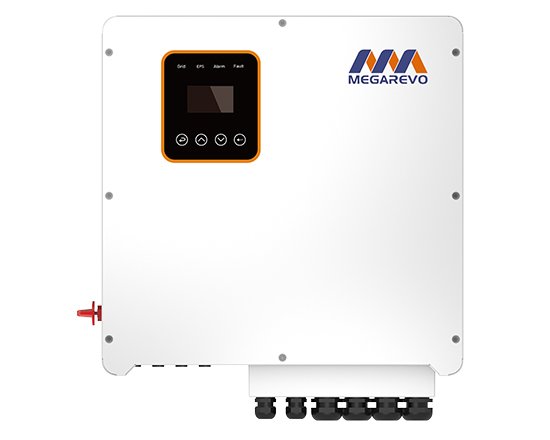As solar energy continues to gain popularity as a clean and sustainable power source, understanding the components of a photovoltaic (PV) system becomes increasingly important. At the heart of any PV system lies the solar inverter, a critical component responsible for converting the DC (direct current) electricity generated by solar panels into AC (alternating current) electricity for use in homes, businesses, and the grid. In this blog, we will delve into the role of a solar inverter in a photovoltaic system, exploring its importance, functionalities, and the impact it has on the efficiency and performance of the overall system.
I. Understanding Photovoltaic Systems
Before we explore the role of a solar inverter, let's briefly understand the basic components of a typical photovoltaic system. A PV system consists of solar panels, a solar inverter, mounting structures, and electrical wiring. Solar panels, made up of photovoltaic cells, convert sunlight into DC electricity. However, since most appliances and the power grid operate on AC electricity, a solar inverter is necessary to convert the DC electricity into the usable AC form.

II. The Role of a Solar Inverter
1.DC to AC Conversion
The primary role of a solar inverter is to convert the DC electricity produced by solar panels into AC electricity. AC electricity is the standard form of electricity used in homes, businesses, and the power grid. The inverter takes the variable DC voltage produced by the solar panels and converts it into a stable AC voltage suitable for powering appliances and feeding into the electrical grid.
2.Grid Interaction
Solar inverters play a crucial role in facilitating the integration of a PV system with the electrical grid. In grid-tied systems, excess electricity generated by the solar panels can be fed back into the grid, allowing for net metering or even selling the surplus energy to the utility company. The inverter helps ensure that the AC electricity produced by the solar panels is synchronized with the grid's voltage and frequency, enabling seamless interaction and efficient power transfer.
3.Maximum Power Point Tracking (MPPT)
Solar inverters often incorporate Maximum Power Point Tracking (MPPT) technology, which optimizes the performance of the PV system. MPPT algorithms continuously monitor and adjust the operating conditions of the solar panels to ensure they operate at their maximum power output, even under varying sunlight conditions. This technology maximizes the energy harvesting potential of the solar panels, enhancing the overall efficiency and output of the PV system.
4.Safety and Protection
Solar inverters also play a crucial role in ensuring the safety and protection of the PV system and its components. They monitor the system's voltage, current, and temperature, providing protection against overvoltage, overcurrent, and overheating. In the event of a fault or abnormal condition, the inverter can disconnect from the grid to prevent any potential damage to the system or hazards to the users.
5.Data Monitoring and Communication
Many modern solar inverters come equipped with advanced monitoring and communication capabilities. They provide real-time data on the PV system's performance, including energy production, power output, and system health. This data can be accessed remotely through online platforms or mobile applications, allowing system owners to monitor and optimize their PV system's performance. In addition, inverters with communication capabilities enable seamless integration with smart home systems and other energy management technologies.

III. Types of Solar Inverters
There are different types of solar inverters available in the market, each catering to specific needs and system configurations. Some common types include:
1.String Inverters: These inverters are commonly used in residential and small commercial systems. They are connected to multiple solar panels wired in series (known as a string) and convert the combined DC power into AC power. String inverters are cost-effective and reliable, but their performance is dependent on the lowest-performing panel in the string.
2.Microinverters: Microinverters are installed on each individual solar panel, allowing for panel-level DC to AC conversion. This distributed architecture provides enhanced performance and flexibility, as the performance of each panel is optimized independently. Microinverters also offer better shade tolerance and monitoring capabilities, but they can be more expensive than string inverters.
3.Power Optimizers: Power optimizers are similar to microinverters but operate at the panel level, optimizing the DC power output before sending it to a central string inverter. They allow for panel-level optimization while still utilizing a central inverter. Power optimizers are often used in systems with shading or complex roof configurations.
IV. Conclusion
Solar inverters play a crucial role in photovoltaic systems, converting the DC electricity generated by solar panels into usable AC electricity. They enable seamless integration with the electrical grid, optimize the performance of the PV system through MPPT technology, ensure safety and protection, and provide data monitoring and communication capabilities. Understanding the role and importance of a solar inverter is key to maximizing the efficiency and performance of a photovoltaic system. As solar energy continuesto thrive as a clean and sustainable energy source, advancements in solar inverter technology will continue to enhance the efficiency and reliability of photovoltaic systems, making them even more accessible and beneficial for homes, businesses, and the environment.
Suzhou Baoxinda Energy Technology Co., Ltd. is a high-tech enterprise located at Suzhou FOHO Hi-Tech Industrial Development Zone. The main business is floating solar systems design, rooftop solar mounting systems, system design, solar projects installation, home solar energy systems, C&I solar energy systems, energy storage systems and solar power project development. The designed system annual capacity can reach over 200MW. Our goal is to provide customized solutions for the market and customers, whether it is a single product or a complete set of equipment.
If you need solutions about solar inverter, you are welcome to browse our website or contact us.
Website:www.oneplusenergy.com
Email:vanior@bxdenergy.com


